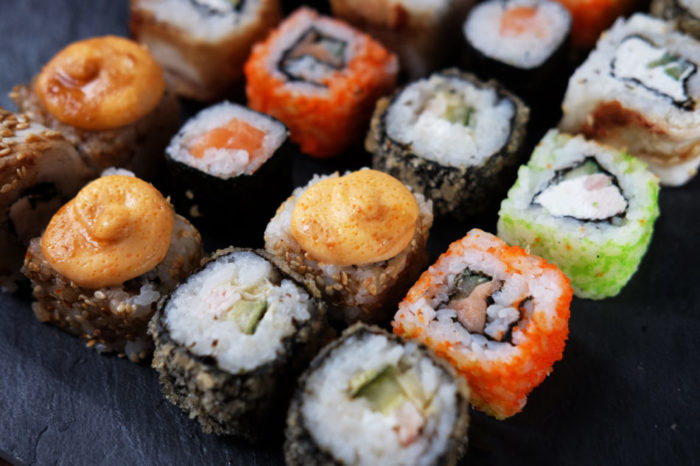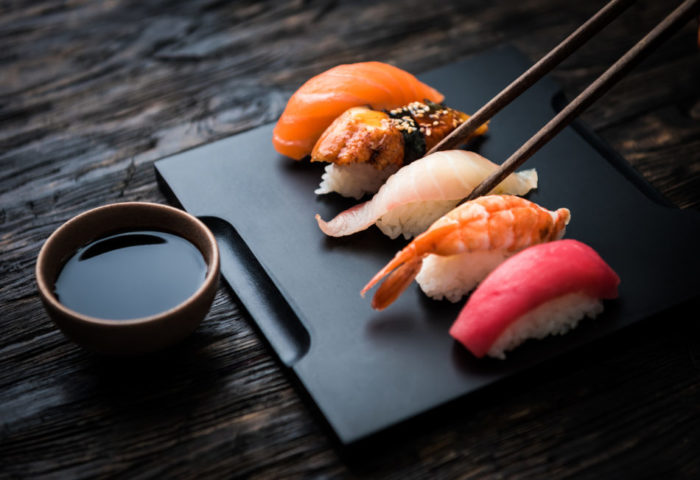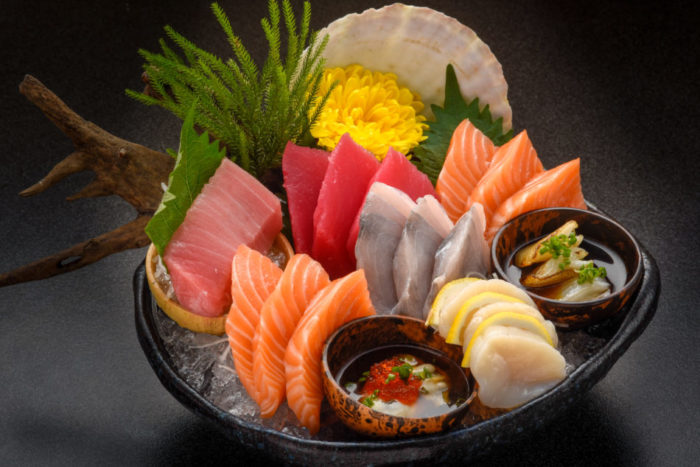Sushi, sashimi, and nigiri are famous dishes from Japan. They all involve seafood and have rather similar serving styles. While the difference is obvious to those familiar with the cuisine, for many of us in the western world, the comparison of sushi vs sashimi vs nigiri is somewhat unclear.
Well, let’s dispel the doubts. We take a closer look at these dishes and see how they stack up and what differentiates them.
Differences And Comparison: How These Recipes Stack Up
Difference Between Nigiri And Sashimi, With An Eye At Sushi
The biggest difference between nigiri and sashimi (or for that matter, sushi and sashimi) is the use of rice. Nigiri uses vinegar rice, as does sushi. However, sashimi never includes vinegar rice or any rice.
Since both nigiri and sashimi use sliced seafood (or other meat), the use of rice is an easy indicator to set these dishes apart. In the conventional sense, nigiri is raw fish served over vinegar rice, without the use of additional components. This separates it from sushi too, which can make generous use of condiments like wasabi.
Besides, both nigiri and sashimi prefer the use of raw seafood. Sushi, on the other hand, can include raw as well as cooked seafood. Sushi and sashimi may often use other types of meat, and even have room for vegan options like tofu.
Many modern chefs, however, skip these subtle differences that separate these three individual recipes. In such cases, it may not be possible to tell apart the dishes. I mean, if you add vinegar rice to the recipe and call it sashimi, the recipe has changed so drastically that the name of the dish becomes irrelevant.
What Is Sushi?

Sushi is perhaps the more famous of this trio. And its popularity has seen the sushi move into various subtypes with many types of ingredients, condiments, and changes to preparation. Items like pressed sushi, rolled sushi, and scattered sushi fall into this category. For the sake of our current discussion, we’ll work with the more conventional definitions for this recipe.
When people think of sushi, they first consider fish as an ingredient. However, in the original recipe and Japanese cuisine, the key element for this recipe starts with vinegared rice (i.e. rice fermented with vinegar). In fact, the word “sushi” literally translates to sour rice, a reference to the taste of rice once vinegar comes into play.
Sushi conventionally includes fish served with medium-grain rice, which has been seasoned with salt, sugar, and vinegar. While the modern consumer always imagines sushi with fish, it can be served with just vegetables and no fish. There are vegetarian sushi options available.
Usually though, sushi does include fish, along with wasabi, soy sauce, and seaweed. It can include fresh, raw fish, though the use of cooked fish is possible as well.
What Is Nigiri?

In essence, nigiri is a type of sushi. It includes vinegar rice as an important component, and also includes raw seafood. However, nigiri avoids the use of additional condiments seen in sushi. Though many modern chefs do include these additional components, like wasabi, pickled ginger, and seaweed.
Generally, it includes sculpted rice and raw fish or similar seafood. Nigiri literally translates as “to grasp”. This is a reference to the sculpted rice holding on to the seafood topping. The rice is usually hand-pressed by the chef and topped with sliced or complete seafood.
In a sense, nigiri is what an average person thinks of sushi – sculpted rice topped with fish (or other seafood).
What Is Sashimi?

Sashimi is another popular recipe very closely related to sushi and nigiri. However, it is pretty unique in its own right.
Sashimi doesn’t contain vinegar rice, or for that matter, any rice. In this dish, daikon takes on the role handled by rice in sushi and nigiri. The main component here is thinly sliced raw seafood. A general preference is given to saltwater fish and seafood, though freshwater varieties can be used as well.
In some cases, vinegar could be added to season daikon and to add more flavor to the recipe. Some might also choose to flavor it with soy sauce and wasabi. Some versions of the recipe skip seafood and use meat instead. This can include beef, venison, or even horse meat. In vegan variations of the recipe, tofu replaces meat and seafood.
Related FAQ
Does Sashimi Contain Rice?
A key aspect in the sashimi recipe is that it doesn’t contain rice. Vinegared rice is the highlight of recipes like sushi and nigiri. It is the lack of rice that highlights sashimi as a separate dish from nigiri or sushi. Sashimi might use daikon with or without vinegar as a part of the recipe.
Do You Eat Nigiri With Chopsticks?
There is no need to use chopsticks with nigiri sushi. You can simply use your hands. Generally, people hold it between their thumb and middle finger. Of course, you could use chopsticks too, but it’s not really a convenient or recommended way to eat nigiri.
Is Sashimi Healthy?
Sashimi is full of nutrients and can be considered healthy. It offers a good amount of proteins, minerals, and vitamins. However, keep in mind that the recipe often includes raw meat, so your sashimi should come from a reputable and safe source.
Is Sushi Healthy?
Sushi can be a healthy food choice. The conventional recipe includes a fair amount of proteins, minerals, necessary fats, and vitamins. However, there are several recipes and cooking style of the dish, owing to its popularity. When eating sushi, consider favoring healthier fish like salmon and mackerel, while avoiding high-sodium soy sauce.
Can You Eat Sushi When Pregnant?
Pregnant women can safely eat seafood and sushi. Eating fish is safe, as long as it comes from a clean, reputable source and has been prepared hygienically. Well, that part applies to pretty much every food. However, pregnant women should avoid fish that are high in mercury. The FDA has a very helpful page with information on this topic.
How To Cut Sashimi?
Being smooth and well-versed with the knife is a key part of cutting sashimi. Choose a good-quality and sharp knife, and slice fish evenly in a steady motion. Ideally, you should cut the fish filet perpendicular to the direction of the spine.
How Long Is Sushi Good For?
How long the sushi lasts depends on the type of sushi and its preparation. If you have sushi made with raw fish, it will last a day or two at best, when kept in the refrigerator. Similarly, sushi made from cooked fish can last 3-4 days in the refrigerator. However, sushi that has stayed at room temperature for two hours or more, should be considered unfit for consumption.
Final Words
Making a choice between sushi vs sashimi vs nigiri can be simple once you understand the comparison and aspects listed here. These recipes from Japanese cuisine are closely related and are extremely popular. When prepared well, these can be very healthy and nutritious dishes.